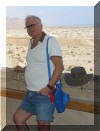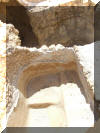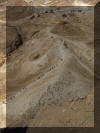 |
To the left, at 0530 in the morning, the sun is not yet up.
The palms in the outskirts of Eilat. To the right, the
airport that stretches through most of Eilat. This airport will in some 5
years be moved to Ovda and the airport made into an hotel complex. |
 |
 |
Desalination plant outside Eilat. All freshwater in Eilat is
taken from the Red Sea. The sleepy outskirts of Eilat. |
 |
 |
The watchful eye of the Israeli Defense Force (IDF). Jordan
is just across the border. Typical desert landscape on the
road to the Dead Sea. Reminds you a little bit about the savannas in Africa.
Even have the arcadia trees or umbrella trees here and there. A well known
feature of the African savannas. |
 |
 |
Hatzeva kibbutz, grounded in the 1950ties by the Israelis.
Here they started with milk production. And it worked. Today, Israeli cows
have the world record in milk production for a single cow. Amazingly enough,
the cows managed the searing heat well. Having a nice lunch
next to Hatzeva and sharing a joke with a fellow traveler, Ingrid. |
 |
 |
The road signs showing the way to Masada.
And desert around the stop. |
 |
 |
More desert. Here the African trees can be seen.
And as on any gas station, gas and oil, but here also water. The source of
all life in this region. |
 |
 |
After a pleasant breakfast, it's time for the road again.
The second largest source of income is minerals from the dead sea. These
rock formations are actually salt squeezed up of the ground by the Asian and
African tectonic plates the collide in this area. |
 |
 |
And you all heard the story about Lot's wife that turned
into a salty statue? Here she is, disobeyed God's will an looked back at the
cities of Sodom and Gomorra while God destroyed them. All along the coast,
health spas for people suffering in particular from psoriasis. |
 |
 |
The Southernmost part of the Dead Sea is parted due to the
fact that the water is reclining. The water input is far less than the water
evaporation. This, the Israelis and Jordanians make the most of by further
subdividing the sea into part with more and more salinity, so in the end
they just shovel up minerals. And there you see this
partition very clearly. In the front, another health spa. Denmark pays for
their psoriasis treatment here. Not so the Norwegians with their immense oil
wealth. They rather give money to Arabs so they can burn our flag.
Only Norwegian can afford so stupid politicians as the Norwegians.
Quote from an English MP. |
 |
 |
At Masada, the Israeli flag and some military (?) ones at
the entrance to the cliff. The story about this palace erected by Herodes,
was used as a last stand against the Romans in 63 AC. It has a central part
of every Israeli recruit today. Our trusty bus parked while
we visit the top of the cliff. |
 |
 |
The commercial area around the lift taking visitors up to
the rock. Having a not so cool orange drink while waiting
for the lift to carry us to the top. The Dead Sea in the background. |
 |
 |
An outline of the plateau itself from some old drawings.
Up to the top. |
 |
 |
The valley below. A breathtaking view. The
view from the top with the backdrop of the Dead Sea in the background. |
 |
 |
More view from the top. Details of the
ropeway that took us there. |
 |
 |
Rare red tipped bird that only lives in this area.
The excavations was a voluntary communal work with participants from all
over the world in the 60ties. After an ad in the English newspaper, The
Observer. |
 |
 |
Our group with Marie, our excellent guide making a point
back turned to us. A model of Herod's bath complex on top of
the cliff. How did they get water up there? Read below. |
 |
 |
Marie and Martin in one of the dugouts on top of the cliff.
Eva and Martin on top of the cliff with the Dead Sea as a backdrop. |
 |
 |
Herod's hanging gardens. A man with a taste for luxury and
all Roman. It only rains some 55 mm in these parts of the
world. When it does, it follows old riverbeds as can be seen as some
vegetation on this picture. |
 |
 |
Stones used to throw at the Romans during the siege in 73.
The whole story is told by Hollywood where Peter Otool played the Roman
commander, Josephus Flavius.
One of the water cisterns on top of the cliff. Water was
carried on donkeys up to these. |
 |
 |
A model of how they managed to save the little rain that
fell. In an ingenious feat of engineering, they led the water into the
caves by channels cut out in the mountain side. When one cave was full, it
overflowed into the next one and so one. I total it could hold some 400 000
m3 of water in total. Some of these water caves
can be seen even today. |
 |
 |
Herod kept pigeon that he kept in these pigeon stalls.
They were of a smaller kind than those of today. The ramp
built by the Romans to finally crush the wall of Masada. The film is highly
recommende. |
 |
 |
Then it was off to Quamran, where they found the Dead Sea
Scrolls in 1947 by a herdsman or shepherd. He recently died.
Another view of the caves. |
 |
 |
A close up of the caves, very inaccessible to humans. The
shepherd was looking for a lost goat when he found them and eventually found
their way to the scholars. Another close up. |
 |
![]() .
.









































